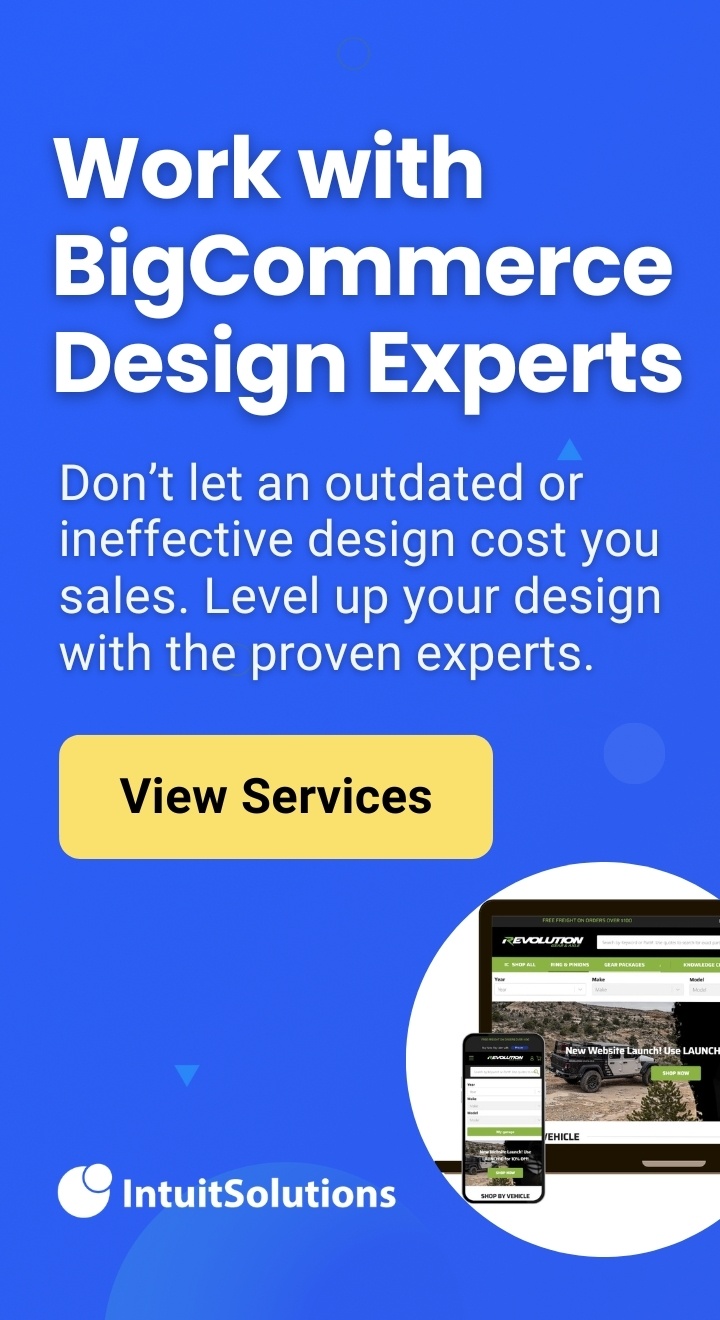An Insider’s Look at Designing, Developing, and Launching a Successful Ecommerce Site Migration
Installment 1: Project Planning Essentials
Are you and your business being held back by an outdated ecommerce platform? For most merchants, the answer is yes, and the time to replatform is now. You know things could be better, but where do you start?
Through this six part series, get an insider’s look at our proven path to success, from goal-setting, evaluation, and discovery, through design, development, and integration, to launch and beyond. Follow the complete migration experience of our client, North Shore Commercial Door, as they upgrade to the BigCommerce Enterprise Platform — backed by the 20+ year ecommerce experts at IntuitSolutions.
Introduction
A well-planned process separates successful ecommerce website projects from those that ultimately fall short of expectations. It’s a blueprint that guides your business and web development partner through each step, from kickoff to launch, to ensure the final product drives profitable business results and delights shoppers.
North Shore Commercial Door’s migration from Yahoo to BigCommerce serves as a powerful case study for what to expect when embarking on an ecommerce design and development project. With their commitment to a disciplined process, North Shore is now reaping the rewards and experiencing a significant return on investment.
Use this series as a guide to consider your own process when starting an ecommerce website project. We will outline how we approach the different planning phases, ensuring a solid foundation for design, development, and post-launch success. Keep in mind that there is no universal approach, and you may need to tailor our strategies to fit your specific needs.
Let’s get started!
Creating an New Ecommerce Website: Why a Structured Process Matters
You can think of an ecommerce site as a combustion engine—hundreds of pieces of all shapes and sizes moving at once to propel your business forward. The product pages, the shopping cart, the checkout process, backend management tools, etc., must integrate seamlessly to provide results for the company and an optimal shopping experience for customers.
Clearly identifying each step in the process makes it easier for team members to know how they play a more significant part in the outcome.
A structured plan keeps projects organized and on track, avoids costly mistakes, and ensures optimal results. It also keeps our team’s communication and progress aligned so there are no surprises along the way.– Lu Cordero, Creative Lead / Sr. Front-End Web Developer, IntuitSolutions
Identifying the big-picture goals is the first step in developing a project plan. With a thorough discovery process, the business owner and website development team will better understand existing shortcomings to identify high-value solutions that create a successful online store.
The Business Case for Redesigning or Replatforming Your Ecommerce Site
There are several reasons why an online business may choose to invest in a new website: the desire for a new look, an upgrade to enhance front and backend functionality, or a migration to a new ecommerce platform with better features and support.
To come away with a website that produces profitable results for your business, all stakeholders must first understand and support the reasons for change.
Common Reasons for a Site Redesign or Migration:
- Lackluster design and aesthetics
- Poor mobile responsiveness
- Outdated user experience
- Antiquated technology
- Limited features and functionality
- Inability to scale for business requirements
- Security concerns and vulnerabilities
- Uncertainty with platform ownership/management
North Shore Commercial Door’s choice to migrate their online store to BigCommerce stemmed from mounting frustrations with their former platform—Yahoo. As their business grew, they needed a more scalable and forward-looking ecommerce solution to provide better design flexibility, improve product management, increase search visibility, and streamline operations.
Luckily, BigCommerce provides a powerful, modern platform to fill the gaps and support their continued growth.
Assessing Your Unique Business Goals
It’s vital to have a clear understanding of your goals at the outset of a new website project. This will help you identify the necessary resources, estimate the time and budget required for the project, and avoid expensive modifications in the future.
Are you focused on improving user experience (for shoppers), increasing conversion rates (for sales), reaching a new target audience, or all of the above? It’s easy to get overwhelmed when you’re starting from scratch. Answer the big questions first to help you narrow down where to focus your attention so you avoid distractions along the way.
Take a few minutes and ask yourself these questions about your business:
- What improvements would help day-to-day operations of our online store
- Where do we envision our online business 5 or 10 years from now?
- Who is the target audience(s) our site intends to serve?
- Does a competitor have a certain site feature we want to make our own?
- Are there industry-specific trends that should be taken into consideration?
Analyzing Your Current Ecommerce Platform for Necessary Improvements
Once you’ve established the high-level objectives, it’s time to assess which aspects of the current site do not support those goals and which design, features, or technology changes will help you get there.
For example, a business that defines “more sales” as an overarching goal will want to pin down current roadblocks and what solutions can help overcome them. A deeper look may uncover issues with site traffic, slow page load speed, or problems with the checkout page.
Teams may also look to resolve backend roadblocks, such as inventory and order fulfillment issues caused by disjointed Enterprise Resource Planning (ERP). Or, an outdated Customer Resource Management (CRM) system may be causing problems with customer retention.
The discovery questionnaire asked targeted questions to help uncover our preferences, challenges, and key differentiators of our business. This gave the design and development team a great starting point to understand our project expectations.
– Matt O’Donnell, VP of Sales and Marketing, North Shore Commercial Door
The Research and Solutions Scoping Process for New Ecommerce Websites
It’s crucial to create a detailed project proposal before allocating resources to build an online store. Doing so helps prevent unexpected costs, project delays, and frustration down the road.
The solutions scoping phase will address questions like:
- What is the expected project timeline?
- What are the final deliverables?
- What is the total cost, and how will overages be handled?
- What input is needed from business stakeholders?
- What third-party solutions (if any) will need to be involved in this project
- What are the in-scope and out-of-scope assumptions?
Once we understand our client’s needs, IntuitSolutions enters a research and solutions scoping process by gathering information and assessing the resources required to execute the project according to our client’s budget and timeline.
During the scoping phase, our team will flesh out the “must-haves” and “wishlist” items our clients present. We’ll also dig deeper into competitors’ websites to objectively assess what works well, what doesn’t, and how your site can build an edge over others in your industry.
With client needs aligned, our team collectively determines if we’ll require additional assistance from outside partners or other third-party solutions.
North Shore’s Migration Goals:
- Intuitive navigation to guide customers through the purchase process
- Stronger SEO features to improve search visibility
- Enhanced data integrity and accuracy for hassle-free future maintenance
- Product feed management across search and online marketplaces
- Two-way integration with SAP Business One ERP
- (Future) platform capability to accommodate B2B buyers
IntuitSolutions’ and Partner Solutions for North Shore’s Goals:
- Modern design flexibility is native to BigCommerce
- BigCommerce’s SEO-friendly structure includes optimized URLs, schema, and more
- Jasper PIM analyzes product data and organizes it consistently in a single place
- BigCommerce Feedonomics automates/optimizes product listings with 160+ online marketplaces
- BigCommerce architecture facilitates easier middleware connections
- BigCommerce provides B2C and B2B functionality in the same platform.
Replatform the Right Way
Say goodbye to technical roadblocks. Experience an ecommerce migration without the headaches.
Assembling a Dedicated Project Team
Delivering a project on time and on budget requires commitment from all sides. Defining expectations upfront will help ensure everyone understands their responsibilities and how their work fits into the bigger picture.
For the North Shore Project and all website builds at IntuitSolutions, a dedicated project manager takes the lead in managing all aspects of the site build. This individual drives the project agenda and ensures that your site is fully planned and deployed according to your timeline and budget.
Ambiguity is the enemy of success. When the roles and responsibilities are clearly defined upfront, you save time, potential conflict, and valuable resources. Each person’s energy is focused where it’s most beneficial, and the process becomes productive and enjoyable.
– Brian Antzcak, Founder and CEO, IntuitSolutions
From the outset of the project, we addressed the variables that keep the project on track, such as:
- What is the project timeline, and what are the key milestones?
- What is the meeting cadence – a regular day, time, and frequency of regular meetings?
- Will meetings be optional or required for members?
- Is there a “chain of command” for getting project deliverables approved?
Measuring Success for a New Online Store
A new ecommerce website is an investment in your business. You want to make sure that your investment pays off, so it’s essential to establish how you’ll measure success for the finished project.
A plan for measuring success includes identifying key performance indicators (KPIs). A KPI is any quantifiable measure of website performance—such as site traffic, page views, or conversion rate—that can be consistently tracked and evaluated over time for changes in performance.
Short-term KPIs may include:
- Features and functionality that work as expected
- Faster page load speed
Long-term KPIs may include:
- Increased page traffic
- Increased sales revenue from new and existing customers
- Increased conversion rates on key pages/categories
- Improved customer satisfaction and retention
Once you have identified your KPIs, you need to establish benchmarks for each one.
For example: if page load speed is one of your metrics of success, what would be an acceptable benchmark—1 second, 2 seconds? Or, if customer satisfaction is one of your metrics, what will be used to define success? A decrease in support requests or an increase in positive customer reviews?
Customize your metrics to keep a pulse on what matters most to your business.
Key Takeaways for Planning Your Ecommerce Migration Project
Comprehensive planning is essential to the success of any ecommerce migration. This involves evaluating business requirements, gaining stakeholder support, and establishing key milestones and performance metrics.
With a clear plan in place, you avoid costly deviations from the project timeline and budget while making sure your ecommerce project delivers the intended value.
When partnering with IntuitSolutions, you won’t have to go at it alone. As a BigCommerce-exclusive agency with more than 20 years of experience developing ecommerce solutions for brands of any size and industry, IntuitSolutions is uniquely qualified to create a custom, best-in-class online store on the BigCommerce framework.
Next Steps
Ready for more insider’s tips to help with your own site migration? Read more about our insider’s look into a successful ecommerce project through our experience with North Shore Commercial Door in our next post, Laying the Design Foundation for an Ecommerce Migration.










